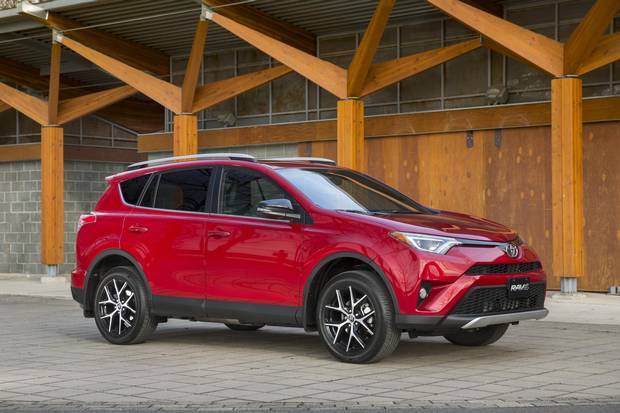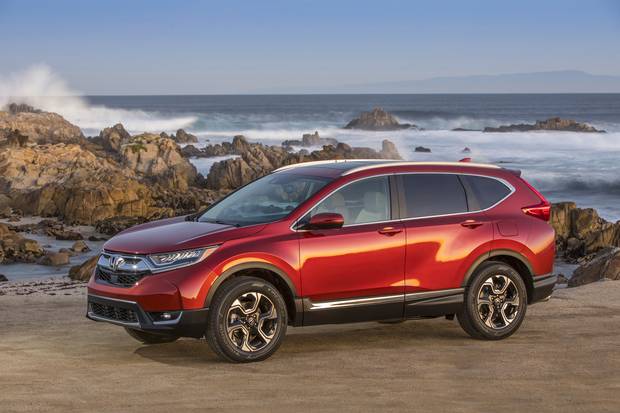It was inevitable. Some time last year, SUVs and crossovers finally outsold cars in Canada for the first time. And so far in 2017, the Toyota RAV4 is the bestselling Toyota in Canada while the Nissan Rogue is the bestselling passenger vehicle in North America.
They're both compact SUVs, which is the most popular segment of all, with comfortable room for five passengers. This year, both auto makers also introduced smaller subcompact SUVs – the Toyota C-HR and Nissan Qashqai – that they hope will add a third as much again to overall SUV sales, but the compact is king.
The size of each SUV generally grows with each generation. The current RAV4 and Honda CR-V, for example, are considerably larger than their original models, as auto makers looked for the sweet spot in size that buyers were seeking. Now, they are introducing smaller models again to appeal to singles and couples who are either before or after the family stage in life.
There's no fixed definition of size that's accepted across Canada, though each auto maker has its own. "The vernacular commonly used nowadays is actually quite informal and doesn't seem to have hard-and-fast rules," says Jean-François Taylor, a spokesman for Hyundai Canada. "The public and journalists all seem to blend Canadian, American and European categories. Some refer to interior volume, some refer to vehicle length."
Hyundai uses external length: A subcompact is less than 4.2 metres long, while a compact SUV is 4.25 to 4.6 metres long. A mid-size SUV is up to 4.9 metres long, and anything longer is considered full-size.
Nissan, however, is less rigid. "It is based on a more abstract collection of vehicles of similar size and price points in the market," says Didier Marsaud, Nissan Canada's communications director. "We make a judgment call."
These are classifications for auto makers to compare one SUV to another. In the showroom, of course, nobody really cares – the right size will just feel right. Buyers want to sit up high and, while they're at it, they want a reasonable amount of space to carry people and things around.
All-wheel drive and rugged capability? Not so much.
This is why crossovers have developed from SUVs in recent years. Buyers weren't looking for rugged winter haulers or rough-road heroes, so expensive features such as all-wheel drive, hill descent control and high approach angles were lost on them; they just wanted to sit taller and have the flexibility of folding seats flat for extra cargo space.
"In the last 20 years, SUVs started to become car-based," says Mike Speranzini, brand director for Buick and GMC Canada. "Now, they offer better fuel economy, a smoother ride and benefits like being easy to get in and out of, and a nice seating position with a commanding view of the road. And they've become more affordable, too.
"People also love the versatility of the seats. In the new [GMC] Terrain, for instance, there's a fold-down passenger seat, so you can carry a couple of two-by-fours home, or a ladder or a roll of carpet."
None of these features will go away, because buyers demand them. Most auto makers find that sedans and coupes account for only about 40 per cent of their total passenger vehicle sales.
"There are several things that impact consumer behaviour in Canada," says Stephen Beatty, vice-president of Toyota Canada. "There's lifestyle and life-stage, and there's energy prices – every time you see a spike in gas prices, you see a change in consumer behaviour.
"The moment the gas prices go up, people shift away from SUVs towards cars; the moment gas prices go down or stabilize, they go back to the SUV side of the marketplace."
Some of that swing may already be proving itself. The RAV4 was Toyota's bestseller last year, but so far this year, it's being edged out again by the compact Corolla sedan. Trucks and SUVs handily outsell the cars, but the Corolla's sales are up almost 19 per cent from 2016.
Canada's bestselling passenger vehicle is still the Honda Civic, as it has been for the past 19 years: It sold almost 65,000 cars in 2016. The Honda CR-V had a record year, however, selling almost 45,000 compact SUVs, alongside another 12,000 subcompact HR-Vs. Honda Canada senior vice-president Jean Marc Leclerc says the figure would have been much higher if more of the SUVs were available to sell.
The CR-V is built alongside other Hondas in three North American plants, including Alliston, Ont., but demand is so strong from international markets that it can be a challenge to bring enough to Canadian dealerships.
Beatty, however, thinks there's another factor in play that will affect the long-term future of compact SUVs.
"I predict a lot of people who grew up with their parents driving SUVs are going to get into their cycle of ownership in the marketplace, and they're going to say, that's just not cool – I want something different," he says.
"That's where you're going to see consumer tastes execute a bit of a shift, independent of any sort of energy prices. I don't know what it's going to be yet, but I suspect it will look closer to a car than a traditional SUV."
Five most popular Canadian compact SUVs
Toyota RAV4

Toyota RAV4.
Globe and Mail
Tried and true, the popular RAV4 (for Recreational Active Vehicle – four-wheel drive) is in its fourth generation, after being introduced to Canada in 1995, the year after its international launch. It's made in Cambridge, Ont., and there's now a hybrid version. This generation is easily identified by not having a spare wheel attached to the rear door, which also swings up, not to the side as before.
Nissan Rogue
Nissan Rogue.
Nissan
Nissan's big seller is now the United States' big seller, knocking the Toyota Camry from top spot in sales for the first four months of 2017 with the help of aggressive incentive pricing. It's only 10 years old and in its second generation, having replaced the boxier X-Trail in Nissan North America's lineup. In the rest of the world, the Tennessee-built Rogue is still called the X-Trail.
Honda CR-V

2017 Honda CR-V.
Honda
Traditionally crossed-shopped with the Toyota, Honda's CR-V (Compact Recreational Vehicle) was also introduced in 1995 and built on the same platform as the Civic. It's assembled at plants around the world for different markets, including Alliston, Ont.
Ford Escape
2017 Ford Escape.
Ford
The Escape began life in 2000 as a collaboration with Mazda, which released its own version as the Tribute. It's in its third generation, and is known in Europe as the Kuga. In North America, it shares a platform with the more-luxurious Lincoln MKC.
Jeep Cherokee
2017 Jeep Cherokee Trailhawk.
FCA
The Jeep Cherokee name has been around since the 1970s, but the modern vehicle has hardly anything in common with that original 4x4. The next-generation Compass is Jeep's official compact SUV, but it's too new for sales to have made an impact.
Shopping for a new car? Check out the new Globe Drive Build and Price Tool to see the latest discounts, rebates and rates on new cars, trucks and SUVs. Click here to get your price.